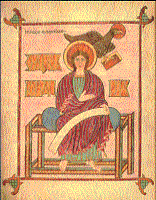

image courtesy of The British Library used here with permission |
Art and Images
|
image courtesy of Monastery Icons used here with permission |
All four of the New Testament Gospels have inspired many artists and artworks over the centuries. However, since certain episodes from the life of Jesus are told very similarly in two, three, or even all four canonical Gospels, it is sometimes difficult to determine which Gospel(s) had the greatest influence on a particular work of art.
The influence of an individual Gospel is obvious whenever the scene being portrayed is found in only one of the Gospels. For example, the "Visit of the Magi" is told only in Matthew 2, while the "Parable of the Prodigal Son" is only in Luke 15. Since the Fourth Gospel (John) is significantly different from the three Synoptic Gospels (Matthew, Mark, and Luke), several well-known stories are unique to John. These "Johannine" stories, especially the Wedding at Cana (John 2), the Samaritan Woman (John 4), the Adulterous Woman (John 8), the Man Born Blind (John 9), the Raising of Lazarus (John 11), and the Washing of the Feet (John 13), have frequently been depicted by artists through the ages. [See also my Contrasts between John and the Synoptics.]
In other cases, even though the same story is in several Gospels, certain details are mentioned by only one Evangelist. For example, all four Gospels tell of how Jesus feeds 5000 people with only fives loaves and two fish, but only John 6:9 mentions that this food was provided by "a young boy." Similarly, each Gospel obviously describes the crucifixion of Jesus, but only John 19:26-27 mentions the presence of Jesus' mother and "the disciple whom Jesus loved" at the foot of the cross, and only John 19:31-37 tells of a soldier piercing Jesus' side with a lance. Thus, any paintings that depict these details are obviously influenced by John's Gospel (although they may also contain other details that are peculiar to another Gospel).
The following pages list paintings, drawings, and other works of art that are particularly influenced by John's Gospel. Only a few of these images are hosted on this website, while most lines provide links to images located elsewhere on the internet. As far as possible, links have been provided directly to the images themselves, but information has also been given about the date, location, and source of the image, as well as the name, dates, and country of the artist.
PAGES ON THIS SITE:
John 1, esp. John (the Baptizer)
John 2–3, esp. the Wedding at Cana
John 4–6, esp. the Samaritan Woman
John 7–8, esp. the Adulterous Woman
John 9–10, esp. the Man Born Blind
John 11–12, esp. the Raising of Lazarus
John 13–17, esp. the Washing of the Feet
John 18–19, esp. the Crucifixion and Burial Scenes
John 20–21, esp. Mary Magdalene & Doubting Thomas
Depictions of JOHN the Evangelist
Collections and Analyses of Art related to John's Gospel:
-
The Dore Bible Illustrations: John - fourteen woodcuts by Alsacian artist Gustave Doré (1832-1883)
-
Renaissance Art in the Gospel of John - a project by my students, Veronica Frausto and Suzanne Quinn
-
The Text This Week: Art Concordance: John - another relevant collection, by Jenee Woodard
-
St. John the Evangelist: The Iconography - a brief article, with links to a variety of artistic depictions
